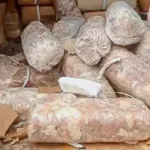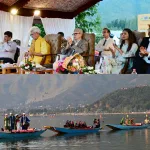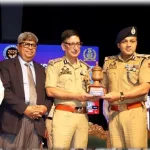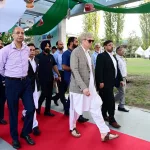The historic decision to abrogate Article 370 marked a defining moment in the history of Jammu and Kashmir under the leadership of Prime Minister Narendra Modi. This article aims to delve into the roots of this significant move, shedding light on PM Modi’s profound understanding of the Kashmir issue and the intricate layers involved in its resolution.
PM Narendra Modi’s approach to the Kashmir issue was grounded in both theoretical knowledge and firsthand experiences. In the mid-1980s, as an RSS worker, PM Modi brought attention to the discriminatory nature of land laws in the region, specifically addressing Articles 370 and 35A. This early recognition of the systemic issues laid the foundation for his future endeavors.
Transitioning to a BJP worker, PM Modi engaged directly with the challenges faced by the people during the turbulent late 1980s and early 1990s, gaining invaluable insights into the ground realities of the region. These formative years shaped PM Modi’s perspective, leading him to realize that achieving true integration of Jammu and Kashmir with the rest of the nation necessitated addressing and eliminating the discrimination perpetuated by Article 370.
The year 1992 proved to be a critical juncture in PM Modi’s engagement with the Kashmir issue. Entrusted with organizing the Ekta Yatra, a 45-day-long journey that commenced from Kanyakumari and culminated in Srinagar, PM Modi faced open opposition from terrorists who resisted the hoisting of the tricolour on Kashmiri soil.
Despite a tragic terrorist attack near Phagwara that resulted in six deaths and 50 injuries, PM Modi’s resolute determination to reach Srinagar and unfurl the national flag showcased his unwavering commitment to national unity. He declared unequivocally, “The tricolour flag will be proudly hoisted in Kashmir, an integral part of India.” This defiance against terrorist threats during the Ekta Yatra demonstrated PM Modi’s steadfast resolve and laid the groundwork for future decisions on the Kashmir issue.
In the same year, a pivotal decision was made during the meeting of the National Executive Committee of the BJP in Bhopal to send a ‘study team’ to the Kashmir Valley for an on-the-spot assessment of the prevailing situation. From September 19th to 22nd, 1992, PM Modi, then the BJP Gujarat General Secretary, accompanied Madan Lal Khurana and Chaman Lal Gupta on a 4-day intensive tour of the Kashmir Valley.
This comprehensive visit allowed PM Modi to meet with various officials, engage with the local populace, visit strongholds of extremists, and tour migrant camps to understand their concerns. The team also assessed the flood situation at that time. The visit served as a bedrock for understanding administrative issues in Kashmir, providing PM Modi with insights into the deep-seated problems of extremism and corruption intertwined with the government.
The report produced by the ‘Kashmir Study Team’ covered all aspects plaguing Kashmir at that time, including policy paralysis, lack of political will, extremists taking over civil administration appointments, unprecedented levels of corruption, lack of tax collection, and instances of extremism. This multifaceted understanding became crucial for PM Modi’s future policymaking, setting the stage for the comprehensive integration of Kashmir with the Union of India during his tenure as Prime Minister.
Throughout the 1990s, PM Modi continued to immerse himself in the local culture, spending a significant amount of time living among the people. His extensive travels across various districts in Kashmir, including Kupwara, Bandipora, Ganderbal, Baramulla, Budgam, Srinagar, and Shopian, allowed him to witness firsthand how prevailing militancy was affecting the youth.
In his words, PM Modi was “worried about heaven turning into hell for Kashmiris.” He recognized that militancy and terrorism in the region were fueled by Pakistan, engaging in an undeclared war against India through terrorist activities. PM Modi’s empathetic engagement with the local populace, especially the youth, laid the groundwork for his understanding of the complex dynamics at play in the region.
As the Kargil war erupted between India and Pakistan in 1999, PM Modi demonstrated swift action by landing in the Tiger Hills to meet the soldiers. He organized on-ground mobilization of BJP workers to support the soldiers during this critical time. Personally meeting brave soldiers at 18,000 feet and visiting the injured soldiers, PM Modi gained insights into the challenges faced during war. The interactions emphasized the importance of political will and leadership in motivating soldiers to achieve victory despite daily battles and sacrifices.
This firsthand experience during the Kargil war solidified PM Modi’s understanding of the psyche of soldiers, who were willing to go to great lengths to protect the nation, especially when political will was on their side. This understanding became instrumental in shaping PM Modi’s approach toward national security and defense.
In 2000, during an event at Srinagar, PM Modi emphasized that Kashmiris needed work and jobs for the state to progress. PM Modi realized that Article 370 was not just a territorial problem; it was also impacting the lives of people living there, hindering promising careers and holding the region back. However, the state government at that time attributed the lack of development to a lack of autonomy.
In November 1996, the Farooq Abdullah-led state government established a State Autonomy Committee, chaired by Dr. Karan Singh and later by PWD Minister Ghulam Mohi-ud-Din Shah, to recommend measures for restoring autonomy to J&K. The committee’s report, adopted in 2000, proposed changes that could reverse J&K’s integration with India.
Key recommendations included altering “temporary” in Article 370 to “special,” limiting the union government’s legislative powers to defense, external affairs, and communication, changing titles to “Sadar-i-Riyasat” and “Prime Minister,” removing the jurisdiction of the Supreme Court, Election Commission, and Comptroller and Auditor General, making Fundamental Rights and Articles 356 and 357 (President’s Rule) inapplicable to J&K, and withdrawing central services such as IAS & IPS.
As the General Secretary of BJP and party in charge for J&K, PM Modi led the party’s criticism of the report. He even organized protests in Srinagar against the orders, apart from vociferously protesting against it himself. This resolution was studied by the BJP and PM Modi in-depth, and its flaws were highlighted to the nation through media and interviews.
This early understanding of the legislative complexities of Article 370 showcased PM Modi’s foresight and comprehension of the potential implications of proposals aimed at restoring autonomy to J&K. Even before assuming any governmental position, PM Modi actively opposed measures that could jeopardize the region’s integration with India.
Even after PM Narendra Modi assumed the role as the head of state in Gujarat, he continued to visit the region and maintain direct relations with the people of J&K. On one occasion during an Inter-State Council meeting in Srinagar under the Vajpayee government, then CM Narendra Modi attended as the CM of Gujarat.
In Srinagar, terrorists threw grenades, triggering an exchange of fire. Negative media coverage portrayed these events as undermining PM Vajpayee’s peace efforts in J&K. Then CM Narendra Modi recognized the need to send a clear signal to militants that they wouldn’t stall government efforts in J&K through fear.
In response, CM Modi’s decision to walk to Shankaracharya Hill sent a powerful message, once again demonstrating his refusal to bow down to the intimidation of terror – a hallmark that would define his prime ministerial tenure. This act emphasized PM Modi’s commitment to maintaining peace in the region and his resolve to not let the actions of terrorists dictate the course of governance.
On numerous occasions, PM Modi also engaged with the youth of J&K, hosting student delegations from the region. His interactions were characterized by a sensitive approach, earning positive reactions from the local population. It was during these interactions that PM Modi understood the importance of addressing the problems in Kashmir with love and sensitivity. He recognized that the youth held the key to the region’s progress and that empowering them could lead to sustainable development.
During his first-ever election rally in J&K for the 2014 Lok Sabha elections, PM Narendra Modi chose to highlight the discrimination faced by SC, ST, OBC, and women due to Article 370 and Article 35A. Specifically pointing out how Article 35A restricted women in the state from owning or inheriting property, PM Modi signaled his intent to address these issues if elected to power. This speech reflected not only his commitment to equality and justice but also his keen understanding of the specific challenges posed by the existing legal framework in J&K.
The removal of Article 370 had long been part of the BJP’s manifesto, and PM Modi fulfilled this promise at the beginning of his second Prime Ministerial term, after laying the groundwork for it in his first term. The comprehensive integration of Jammu and Kashmir into the Union of India was not just a political decision; it was the culmination of years of understanding, experiences, and a commitment to address the multifaceted challenges faced by the region.
PM Narendra Modi’s journey in unraveling the complexities of the Kashmir issue reflects a nuanced and multifaceted approach. From his early years as an RSS worker highlighting discriminatory land laws to organizing the Ekta Yatra in the face of terrorism, and from leading a ‘Kashmir Study Team’ to actively opposing measures threatening autonomy, PM Modi’s understanding of the Kashmir issue evolved over the years.
His empathetic engagement with the people, especially during challenging times like the Kargil war, showcased a leader who understood the psyche of the region. PM Modi’s direct interactions, protests against proposed changes, and efforts to address discrimination demonstrated a commitment to the well-being of J&K’s residents.
PM Modi’s decisive action in removing Article 370 marked a historic step toward the comprehensive integration of Jammu and Kashmir with the rest of India. This move was not only rooted in political will but also in a deep understanding of the region’s complexities gained through decades of experience, interactions, and a commitment to national unity and development. The abrogation of Article 370 marked a significant turning point, unleashing a series of transformative initiatives aimed at fostering development, inclusivity, and prosperity in the Kashmir Valley.
Since August 5, 2019, the government has embarked on an ambitious journey to enhance infrastructure in the Kashmir Valley. Projects related to road construction, connectivity, and the development of educational and healthcare facilities have gained momentum. These initiatives aim to improve the overall quality of life for residents and foster economic growth.
The government has taken measures to boost economic activities in the region. Schemes promoting entrepreneurship, investment, and industrial development have been introduced to create employment opportunities. These initiatives seek to empower the local population economically and contribute to the region’s overall prosperity.
The government’s commitment to development, security, and inclusive governance has instilled a sense of hope and optimism among the residents. The journey towards comprehensive progress is ongoing, with a collective aspiration for a brighter and more prosperous future for the people of Kashmir.
(Author is Professor & Chairman, Centre for Narendra Modi Studies (CNMS), New Delhi. Former Head & Group Editor, Roznama Rashtriya Sahara (National Urdu Daily) & Aalami Sahara TV (Urdu News Channel). Former Media Advisor, Aligarh Muslim University, Aligarh. Email: [email protected])





